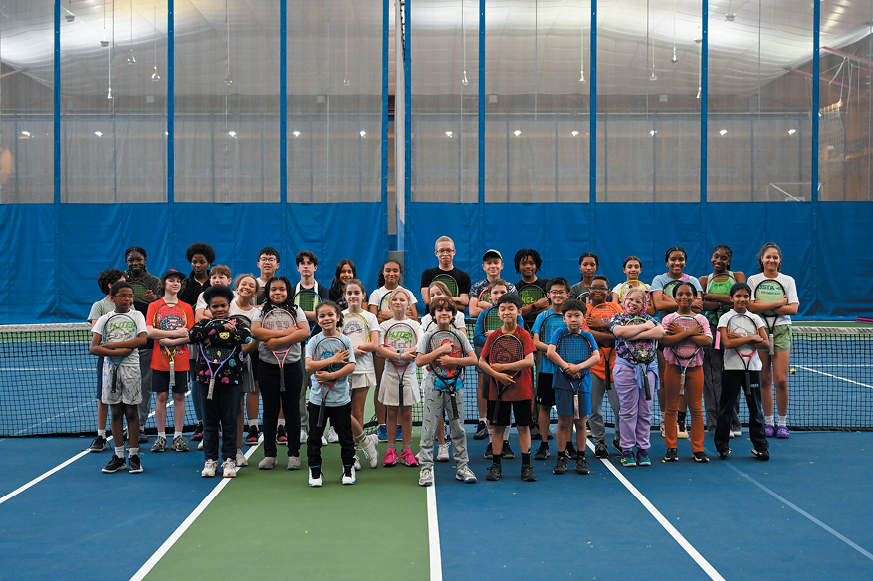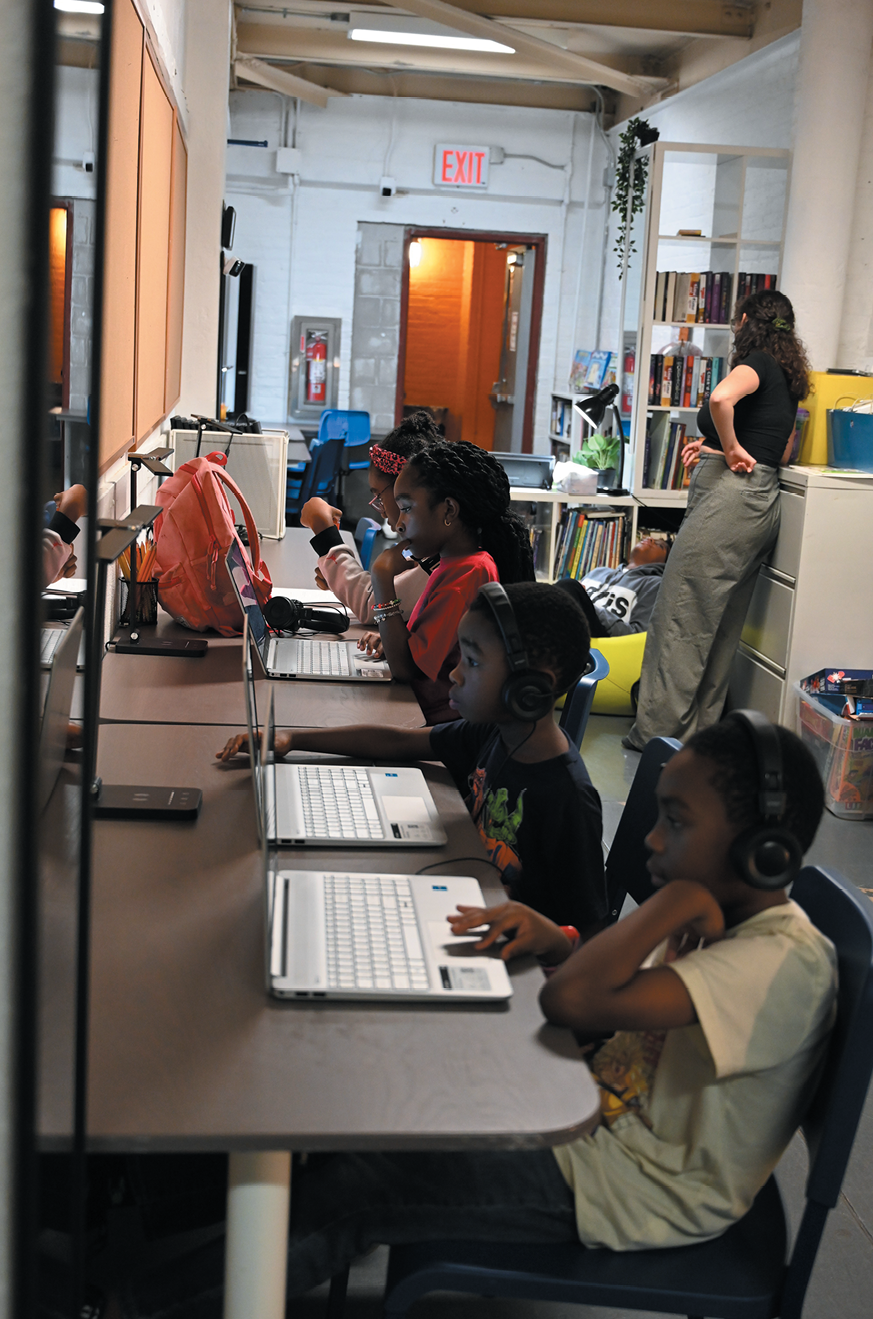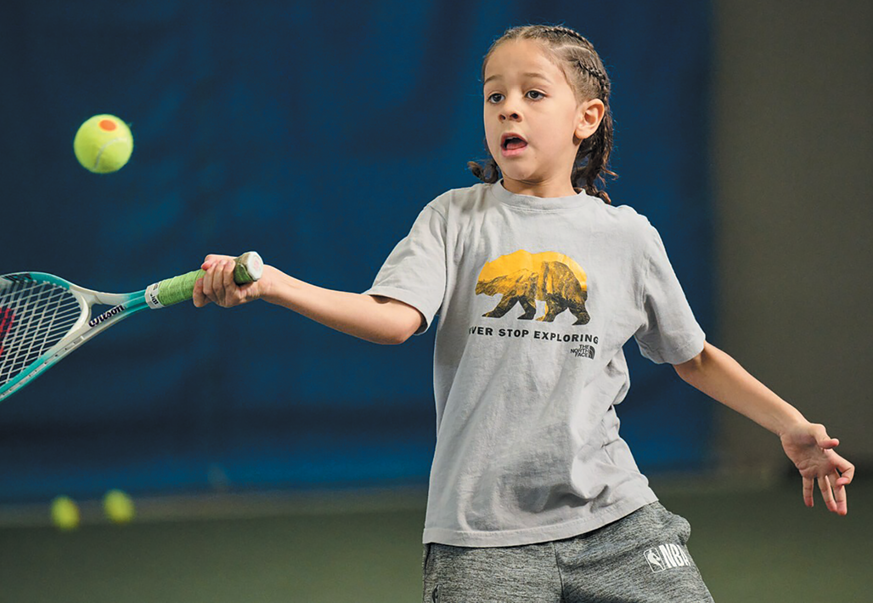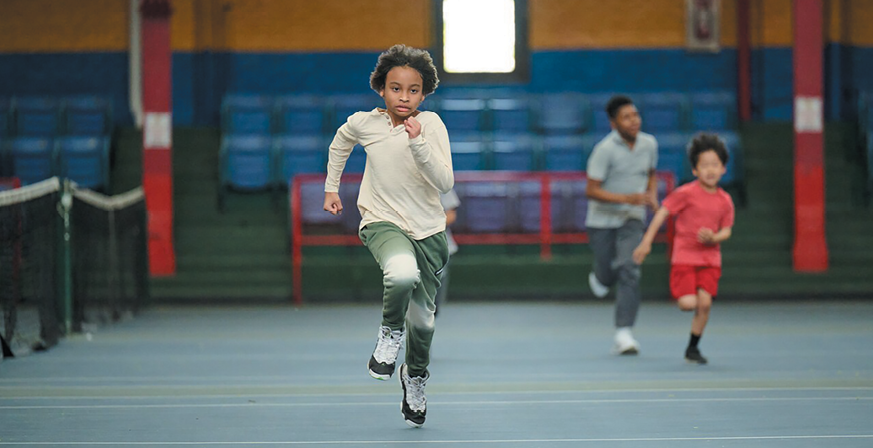- Home
- Media Kit
- MediaJet
- Current Issue
- Past Issues
- Reprints (PDF)
- Photo Specifications (PDF)
- Contact Us
- PRIVACY POLICY
- TERMS OF USE
![]()
ONLINE
![]()
ONLINE

Building Champions
In Life
Editors’ Note
Katrina Adams started playing tennis at age six in a Chicago parks program. At 16, she was a two-time Illinois High School Association singles champion. Recruited by Northwestern University, she earned the NCAA doubles title there in 1987 and was twice voted All-American. In 1988 she joined the WTA Tour, retiring in 1999 with 20 career doubles titles. Adams was a USTA national coach from 1999-2002, helping to develop some of the nation’s top tennis players. She is currently an analyst for the Tennis Channel and a Co-Host for CBS Sports Network. In 2005, Adams, a RSPA and PTR certified teaching professional, joined HJTEP and has grown the enrollment to over 800 participants and increased the operating budget to more than $2 million. She served as the Chair and President of the USTA from 2015-2018 and as the Vice President of the International Tennis Federation (ITF) from 2015-2023.
Organization Brief
The Harlem Junior Tennis and Education Program (hjtep.org), is a not-for-profit organization that has kept its doors open nearly 365 days a week for the past 50 years to boys and girls who reside in the high-risk, low-income neighborhood of Central Harlem, and other parts of New York City. The majority of its student-athlete population are students of color. During the school year, HJTEP serves approximately 800 students and enrolls between 150-300 students in its summer programs. What the organization’s student-athletes experience on the courts, and in its education and wellness programs, develops the whole child – in sports, school and life. Tennis teaches kids essential life skills, sportsmanship, self-discipline, social and emotional competence, as well as how to fight obesity and lead healthier lives. HJTEP leverages tennis as a medium to provide academic and athletic support, and to promote physical and mental wellness among a diverse group of inner-city youth.

Harlem Junior Tennis and Education Program
supports youth in tennis, education, and wellness
(above and following)
Will you highlight the history of Harlem Junior Tennis and Education Program and how HJTEP has evolved?
Two Harlem residents and tennis enthusiasts, Claude Cargill and Bill Brown, started HJTEP in 1972 at the local 369th Regiment Armory on 143rd Street. They understood that few kids in the Harlem community had exposure to the mostly white-dominated sport. They saw tennis as a means for betterment and a powerful character-builder that instills polite behavior and consideration of others. They also knew that African-American tennis greats Arthur Ashe and Althea Gibson, who had played at the Armory, would make great role models for young players. One of the first African-American policemen in New York, Cargill retired as a youth patrolman in 1962. He had organized and coached Police Athletic League basketball programs and had privately supported youngsters by buying tennis equipment, paying tournament entry fees, providing room and board, and securing private coaches for players that demonstrated promising talent. While the two founders gave tennis lessons and subsidized the fledgling program, former Knicks player Earl (“the Pearl”) Monroe helped them attract outside funds. Monroe and Bill Holloway, another tennis instructor, teamed with Mutual of New York (MONY) Financial Services to sponsor an annual invitational tournament to benefit the program. But Cargill’s and Brown’s ambitions for their young players went much further than the sport. In 1979, they launched a Homework Club to provide tutoring and academic counseling. Their early emphasis on education has only grown in recent years. The academic support we offer our students provides them access to higher education and professional mobility. Our founders would be gratified to know that 80 percent of HJTEP’s program graduates go on to college.
Today, we offer tennis, academics, and wellness components, providing these services to 150 student-athletes in the Armory and tennis to an additional 650 students from different schools and community centers in Harlem during school hours or during the summer, exposing them to the sport. We also have over 500 youths on the waitlist each year, as we just don’t have enough space to serve all who are interested in being in our program at the moment.

How do you define HJTEP’s mission and purpose?
Our mission is to develop champions in tennis, education, and wellness. Our holistic programs develop how children perform on the court, navigate their academic journeys for excellence, and drive toward their futures. Ultimately, we use tennis to get the kids in the door with the goal of assisting them with earning a college scholarship through academics and/or tennis financial assistance.
We are one of 250+ NJTL Chapters across the country who are able to collaborate with other like-chapters, share best practices, learn from one another and cheer each other on. NJTL is the National Junior Tennis and Learning network, which was co-founded by Arthur Ashe, Charlie Pasarell and Sheriden Snyder in 1969 with the intent that the programs would teach young people the importance of character, education, and becoming productive citizens by using tennis to teach life lessons. The NJTL is managed by the USTA Foundation and we are very proud to be a chapter. We work hard annually to meet the criteria so that we can apply for multiple grants for both financial and other resources to assist us in accomplishing our goals.
Will you provide an overview of HJTEP’s programs?
HJTEP accepts ages 5-18 years at any stage of development, from the first introduction to the game through advanced levels of play. HJTEP student-athletes take the sport of tennis seriously, knowing it will enrich their lives exponentially, and most stay with us for an average of between 5-10 years. Aspiring student-athletes advance through the tennis program by progressing through each level of play: Grassroots I & II; Futures & Intermediate; High Performance I & II. Their ultimate goal is to be selected for The Tournament Team, where they will have attained high standards of play and academic achievement.

Our metrics for success in the tennis program include striving for 100 percent player retention while qualifying 36 percent of our players for tournament play and at least 13 percent of HJTEP athletes competing at the national level. Our most advanced players will have also gained tournament experience at the international level.
At HJTEP, our goal is to provide the resources that inspire student agency, support the development of executive functioning skills, and create an environment where excellence in academics, personal wellness, and tennis are an achievable reality for every child. We help move the coping needle a little farther along every day – ultimately building individualized success for the children that walk through our door.
Our Learning Resource Center (LRC) is equally weighted with tennis in the weekly experience of all HJTEP student-athletes. The LRC delivers a diagnostic assessment for every child at the start of each school year so that our families have an early and clear picture of where their child stands in relation to grade level. We also provide relevant educational and mental health supports, private tutoring, mentorship, meditation, and mindfulness practices along with financial literacy activities. HJTEP requires a baseline of at least a 2.0 GPA to remain in our program. However, our high standards and practices consistently produce students with excellent academic achievement, with an average GPA of 3.1.
Through this, we provide:
When it comes to wellness, our goals are to help kids maintain a healthy weight, get good grades in school, enhance self-esteem and develop a lifelong passion for staying healthy. Regular exercise, good nutrition and an attitude of readiness are vital not only in tennis, but holistically, in a young person’s life.
All players must participate in cross-training sessions prior to the start of daily tennis instruction. These sessions are tailored to each program level.
We focus on five areas in our wellness components to have balanced successful outcomes both on and off the court – Fitness, Nutrition, Discipline, Mental Resilience, and Fun.

How critical are metrics to measure the impact of HJTEP’s work?
Metrics are critical to understand your success and to tell your story. When you have been around for as long as we have, since 1972, we have a very successful story to tell. Over 95 percent of our kids have graduated from high school since 1972, 100 percent since 2006. 80 percent+ have gone on to college with 65 percent receiving non-athletic financial aid and 25 percent receiving tennis scholarships. That’s a great story. But we are starting to measure more areas to understand the social emotional learning impact of what we do because it’s the long-term development of the child that means the most. This is also evident in the success represented by the professions of our alumni. Our graduates are C-suite holders, doctors, lawyers, politicians, professors, technology software developers, etc. We are building champions in life.
How valuable has it been for HJTEP to have such an engaged and committed board of directors?
Our board of directors are our lifeline. Without their support, I couldn’t do what I do to support my staff and student-athletes. We have been around for a very long time and we have a bigger vision in sight for us, which is to expand to serve more youth in Harlem and the surrounding communities in New York City. To do this, in addition to the Armory, we need to build our own facility, which would be open to the public, also serving adults, outside of our program hours, offering court time for clinics, leagues tournaments and other events. Our board is committed to this, which will be a heavy capital campaign lift and I am thrilled about it because the number one goal is providing more opportunities and exposure for our youth.
However, besides the capital campaign, we have daily operational needs to serve our population, which is no easy task either. We currently have a budget of $2 million+ but it should be $5 million, however, I need more donations and grants to make that a reality. Although we appear to be a “community” program, we are much more than that. Yes the majority of our youth reside in Harlem, which is one of the most historical communities in Manhattan, I might add, but we serve youth from all over New York City. Why? Because they find the quality of our programming so good that they are willing to travel up to two hours to get to us. And our board recognizes that value and our strength in what we offer. We need our potential new donors to recognize that we are building champions in life from an inner-city community that is diverse, historical and has cache to its name. Althea Gibson grew up a block away from our facility, where she first learned how to play tennis. She played inside our facility. Arthur Ashe played inside our facility, as well as several other tennis champions. James Blake grew up in our program. We have history. We want to build on that for the next century, but we need more support.
Did you always know that you had a passion for nonprofit work?
I was raised by parents who were teachers and always gave back. They were on several community boards in Chicago and taught me and my siblings the importance of making a difference and giving a helping a hand. I grew up in a program similar to this in Chicago, so I understand the importance of HJTEP, what it offers to youth, the life skills that tennis offers and the opportunities that are ahead for those that come through our doors. I am living proof of what a program like HJTEP can do for you and we have hundreds of success stories of alumni which came from this program. So, nonprofit work is in my blood and I have served on many nonprofit boards over the years to make a difference and give back, but HJTEP is my passion.
You joined HJTEP 19 years ago. What has made the experience so special for you?
I started working at HJTEP in December 2005. When I first walked through the doors of the Armory, I knew it was a special place – the history that was there and the success of the program for the previous 33 years. I wanted to be a part of taking the program to the next level. The facility was due to be renovated and reopen in the fall of 2006, providing us with properly surfaced tennis courts, nice classrooms, and a computer room. These would allow us to elevate our program. At that time, we were the Harlem Junior Tennis Program, offering Homework Help and SAT/ACT support. I suggested to the board that we rename it the Harlem Junior Tennis & Education Program and work to provide a full academic component that encompassed more. The name changed, but it took several years for us to get to where we are today. We are now bursting at the seams with our offerings. We have so much to offer and so much more we want to provide, but there is not enough space or resources at the moment to make that a reality – however, we will get there.
The most special part is the community of the kids, parents, and staff that we have. We are not just another program; we are a family. A family that is connected through the sport of tennis, thriving to provide life skills on and off the court, building champions in life.![]()